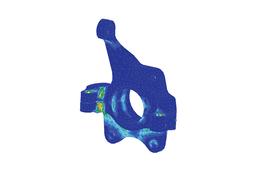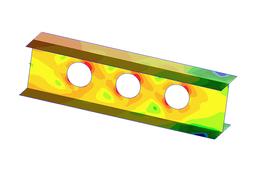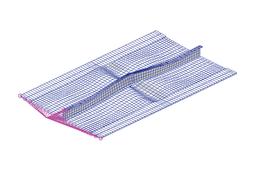
Multidiscipline Simulation Software Supplier, Linear and Nonlinear Finite Element Analysis (FEA), Control Systems Simulation and more
Raising the bar for CAE accuracy, precision & performance
At most companies, CAE is performed as an isolated activity within a single functional team or engineering discipline. The performance, safety, and reliability of their products, however, is greatly influenced by the interactions between these disciplines.
With 50+ year history stretching back to the early NASA moon landing project, MSC Software has been endeavoring to provide world class CAE co-simulation solutions to engineers worldwide. And here are a few reasons why CAE engineers benefit from our unique co-simulation technologies.
Holistic Performance
Co-simulation provides engineers with a unique, more complete & holistic performance insight by coupling together multiple simulation disciplines. Everything from acoustics to multibody dynamics (MBD), to CFD, to structural analysis, and explicit crash dynamics can be connected together in MSC (see Figure 1).

Increased Accuracy & Precision
"The ability to quickly and easily look at alternatives with co-simulation at a time when we are not locked into any particular approach should make it possible to meet performance requirements with a lighter suspension that can improve the fuel economy of the vehicle."
Technical Expert at Endurance Attribute and Chassis CAE Department, Volvo

Faster Analysis Performance
"The Adams-Marc co-simulation capability more than satisfies our guideline of 'reasonable results in a reasonable time.' With up to a 90% reduction in computation time, optimization using advanced nonlinear FEA becomes practical. Such development provides a great benefit and is crucial for our product development and we are proud to work together with MSC in advancing the technology."
Chief Engineer, Litens Automotive Group


MSC CO-SIMULATION TECHNOLOGIES
Depending on the type of analysis, engineers can use MSC solutions in two ways – Co-Simulation (applying multiple physics to the model simultaneously) or Chained Simulation (passing load case results from one analysis to the next).
1. MSC CoSim Engine
The MSC CoSim Engine has been developed in order to provide a co-simulation interface for the direct coupling of different solvers/disciplines with a multi-physics framework. This first version, readily available today, enables engineers to set up co-simulation models between Adams, Marc and scFLOW.

2. Other Open Co-Simulation Solutions
Besides the CoSim Engine, MSC also supports a list of other co-simulation methodologies, including the Functional Mock-up Interface (FMI), Adams Marc Co-Simulation Interface (ACSI) and so on.

3. Chained Simulation
Chained simulation allows CAE engineers from different departments to integrate multiple disciplines sequentially and improve the overall simulation accuracy. For example, passing the road loads data from an Adams Full Vehicle model to the downstream MSC Nastran model for the stress & durability analyses.

MSC CO-SIMULATION APPLICATIONS:
Fluids + Multibody Dynamics


Deployment of flaps on an aircraft wing


Crosswind Impact on Vehicle Dynamics


Vehicle driving through water puddle



Fuel tank sloshing


Buoyant logs floating under a bridge
Fluids + Structures


Flexible plate in a crossflow


Flag on a flag pole fluttering in a wind


Valve in a tank opening


Diaphragm valve distorting due to fluid force


Ship propeller simulation with fluid-structure interaction


Water jet hitting a pivoting flat plate
Multibody Dynamics + Structures


Vehicle battery scratched by obstacle


Wiper blade mechanism simulation


ATV htting a curb


Forming process simulation


Suspension system simulation with nonlinear bushing


Validating control algorithms for industrial robots
Multibody Dynamics + 3D Environment



ADAS and Autonomous Driving Simulation
Multibody Dynamics + Discrete Element


Vehicle dynamics with complex terramechanics
"Predicting the interaction between the machine and granular materials is key to achieving an optimal design for construction, mining, agriculture, and off-road vehicles. The Adams-EDEM co-simulation solution enables engineers to include high fidelity bulk material loads and forces acting on equipment and increase the accuracy of their system level simulations."
Ian Williamson, Chief Executive Officer, EDEM
Fluids + 1D Simulation



Detailed combustion gasses simulation integrated with 1D system modeling



Detailed cooling water 3D analysis incorporated in the 1D system model



Detailed cooling water 3D analysis incorporated in the 1D system model
Multibody Dynamics + Structures + Acoustics


Noise prediction for gearbox/transmission systems
Electromagnetics + Structures + Acoustics


Acoustic analysis for electric motors
Fluids + Acoustics (Aero-acoustics)



Noise study for exhaust system


































